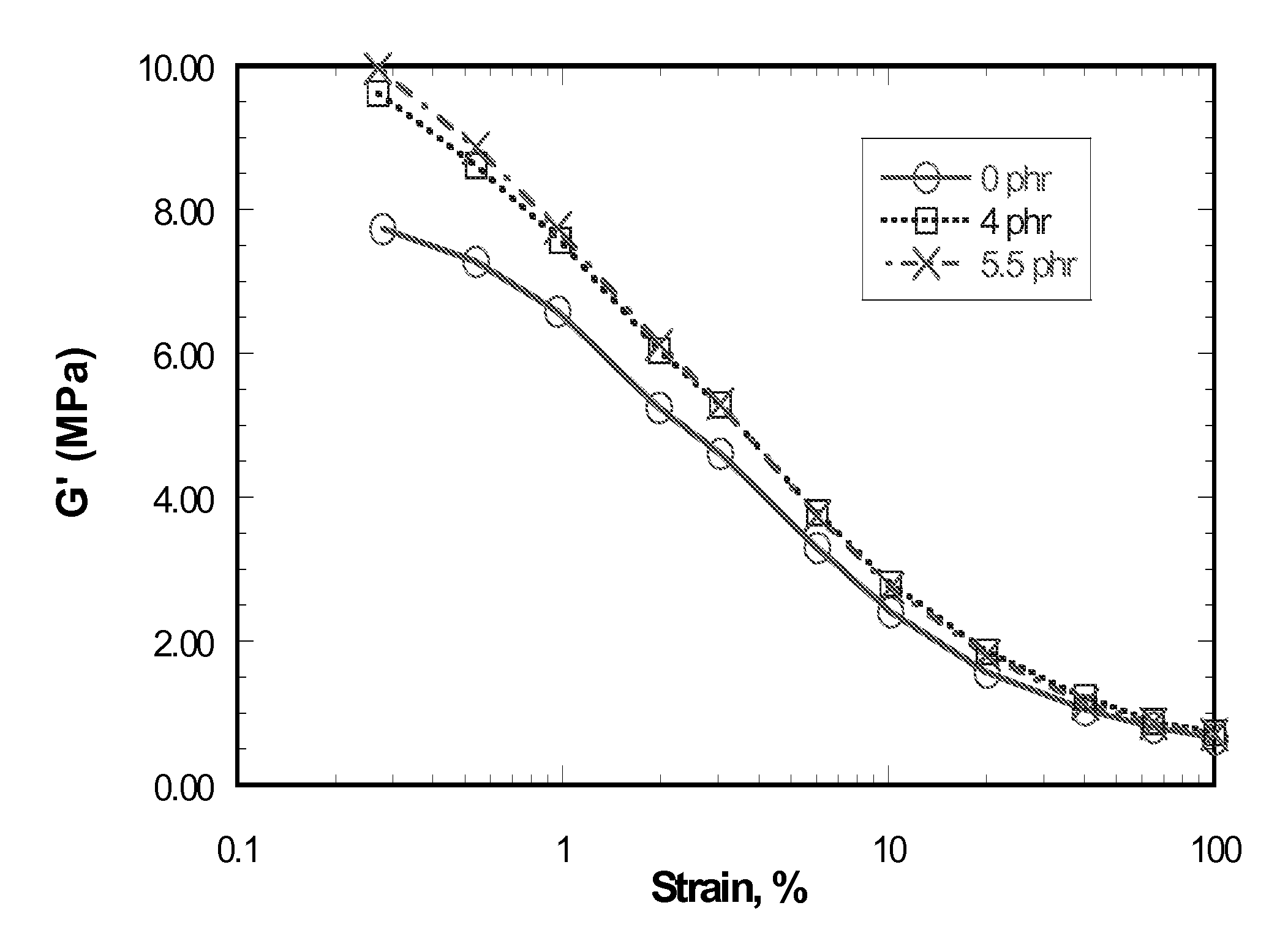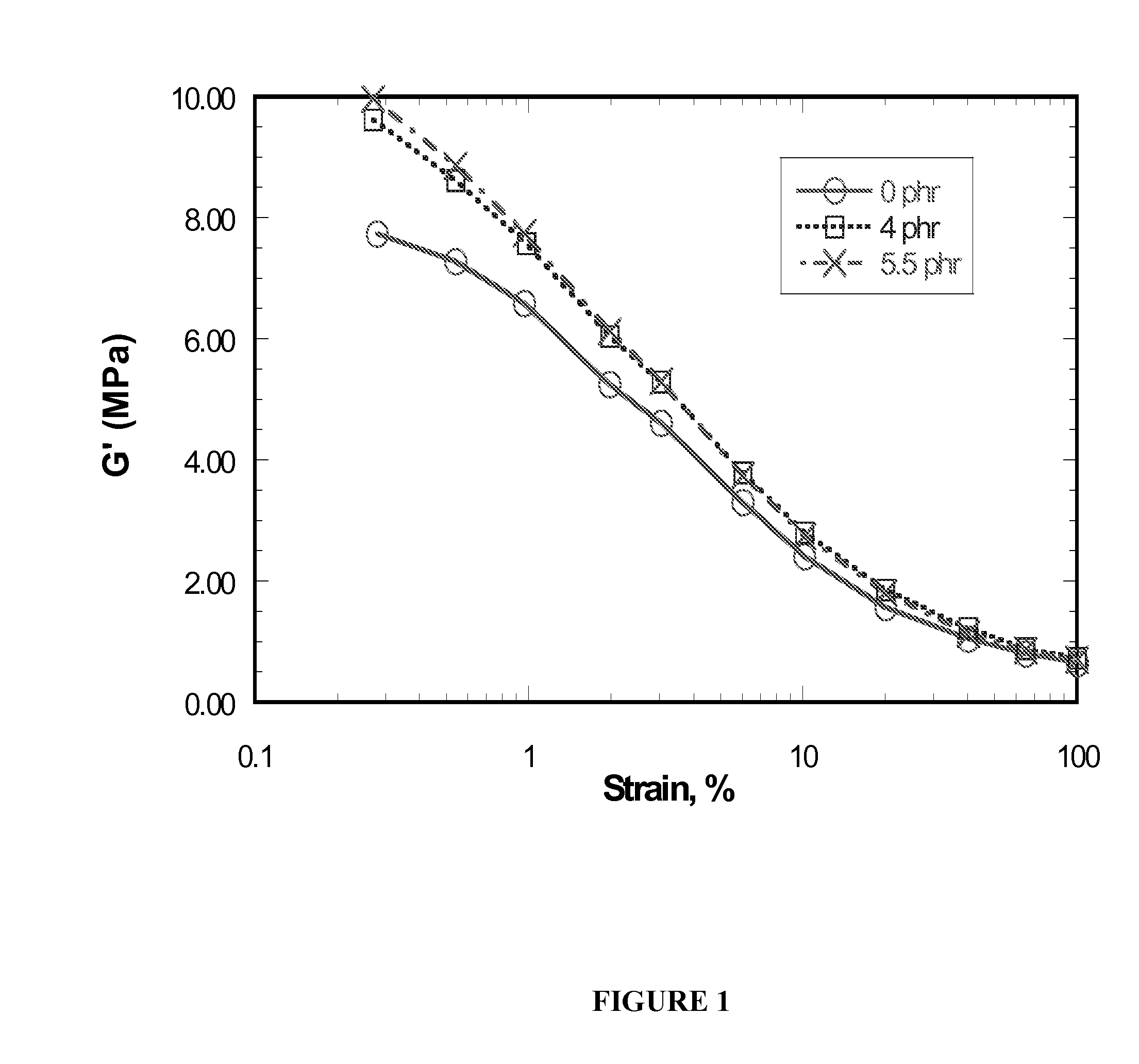Polymerized (substituted imidazolium) for improved handling properties in silica-reinforced rubber compounds
a technology of rubber compounds and silica, applied in the field of high-performance tires, can solve the problems of reducing the performance of tires, reducing the modulus of tires, and sacrificing other beneficial rubber properties, so as to achieve satisfactory processing of silica-containing rubber compounds, increase high temperature hysteresis, and increase the compound modulus
- Summary
- Abstract
- Description
- Claims
- Application Information
AI Technical Summary
Benefits of technology
Problems solved by technology
Method used
Image
Examples
example 1
Preparation of Poly(1-benzyl-2-methyl-imidazolium epichlorohydrin) (PSI)
[0042]A nitrogen purged Brabender mixer (about 300 g capacity) was initially set to 60 rpm and 70° C. The mixer was then charged with 104.6 g of Hydrin H (polyepichlorohydrin, Mw=150K, Zeon Chemicals). After 5 minutes, 197.1 g of Curezol 1B2MZ (1-benzyl-2-methylimidazole, Shikoku Chemicals Corp.) was slowly added into the mixer at a feeding rate of about 2 g / min. After the addition of the Curezol, the Brabender agitation speed was adjusted to 30 rpm and the heating element was set to 150° C. After mixing for 70 minutes, the material in the mixer became very viscous and the temperature was adjusted to 160° C. After mixing for an additional 170 minutes, the heating element of the mixer was turned off, and the resultant product, poly(1-benzyl-2-methyl-imidazolium epichlorohydrin), was allowed to cool. The product was then removed from the mixer.
example 2
Evaluation of the PSI in Silica-Reinforced Rubber Compounds
[0043]The PSI product prepared in Example 1, poly(1-benzyl-2-methyl-imidazolium epichlorohydrin), was evaluated for use in a rubber composition. Two rubber stocks were compounded with silica and a disulfane silica coupling agent, according to the formulations illustrated in Table 1. A comparison stock 1 not containing PSI and a rubber stock 2 containing 4 phr of PSI were prepared. The PSI was added in the master batch stage; although it could have added in the remill stage or any other stage prior to the final stage. All of the charges are listed as parts per hundred rubber (phr). The drop temperatures of the mixing steps were as follows: master batch 1, 154° C.; remill, 143° C.; and final, 105° C. All of the compounded final stocks were sheeted and subsequently annealed at 171° C. for 15 minutes.
TABLE 1Rubber FormulationsIngredientAmount (phr)Natural rubber20 SBR96* Precipitated silica80 PSI (from Example 1)variousAromat...
example 3
Processing Evaluation of Rubber Compound
[0044]The processing of the green stocks (i.e., the stock obtained after the final stage, prior to curing) was characterized as to Mooney viscosity and cure characteristics. In particular, the comparison stock 1 and the rubber stock A containing 4 phr PSI was evaluated by examining the compound Mooney viscosity and scorch data, as illustrated in Table 2. The Mooney viscosity measurement was conducted at 130° C. using a large rotor. The Mooney viscosity was recorded as the torque when the rotor was rotated for 4 minutes. The samples were preheated at 130° C. for one minute before the rotor was started. A Monsanto Rheometer MD2000 was used to characterize the stock curing process. The frequency was 1.67 Hz and the strain was 7% at 160° C. The Ts2 and T90 were obtained from these measurements and represent the time when the torque rose to 2% and 90%, respectively, of the total torque increase during the curing process. These measurements were use...
PUM
| Property | Measurement | Unit |
|---|---|---|
| temperature | aaaaa | aaaaa |
| temperature | aaaaa | aaaaa |
| temperatures | aaaaa | aaaaa |
Abstract
Description
Claims
Application Information
 Login to View More
Login to View More - R&D
- Intellectual Property
- Life Sciences
- Materials
- Tech Scout
- Unparalleled Data Quality
- Higher Quality Content
- 60% Fewer Hallucinations
Browse by: Latest US Patents, China's latest patents, Technical Efficacy Thesaurus, Application Domain, Technology Topic, Popular Technical Reports.
© 2025 PatSnap. All rights reserved.Legal|Privacy policy|Modern Slavery Act Transparency Statement|Sitemap|About US| Contact US: help@patsnap.com



